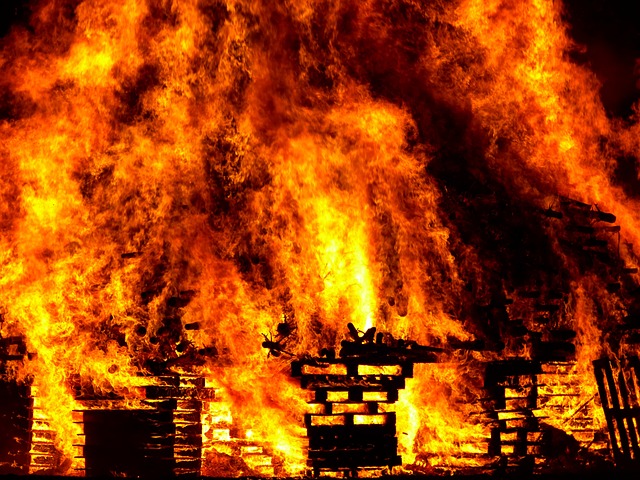
Safeguarding Our Future: The Critical Role of Passive Fire Protection in Irish Schools
As the guardians of our next generation, it is our shared responsibility to ensure the safety and security of our children during their time at school. Among the many facets of this duty, passive fire protection has emerged as a critical component. Passive fire protection refers to the integral design elements of a building that help to prevent the spread of fire and smoke, thus providing valuable time for evacuation and emergency response. In the context of our schools across Ireland, these measures are not just regulatory requirements, they are indispensable assets that can safeguard our children’s lives in the event of a fire.
Alarmingly, recent statistics reveal a concerning trend for educational institutions across Ireland. In the last decade, the Fire and Rescue Services have reported an increase in fire incidents within these structures. On average, there are approximately 1,000 fire emergencies in Irish educational institutions each year. These incidents not only disrupt the educational progress of thousands of students but also pose a sincere threat to their safety. These troubling figures underscore the acute necessity of robust passive fire protection measures in our schools.
Understanding Passive Fire Protection in Schools
Passive fire protection (PFP) is a critical aspect of structural fire safety measures. It is defined as the incorporation of fire-resistant materials and designs into the structure of a building to restrict the growth and spread of fire and smoke. PFP measures are built into the very fabric of a building and work without human intervention, hence the term ‘passive’.
These systems work to compartmentalise a building, effectively creating barriers to the spread of fire and smoke. Measures include fire-resistant doors, walls, and floors, which are rated by their ability to withstand fire exposure for a specified period. Other elements include fire-resistant glazing, firestops, and cavity barriers. These systems serve a dual purpose – they contain the fire to limit property damage and, more importantly, protect evacuation routes to ensure occupants can exit safely. Passive fire protection, therefore, is a vital part of any comprehensive fire safety strategy, providing a ‘first line of defence’ in the event of a fire.
Components of Passive Fire Protection Systems in School Buildings
The cornerstone of passive fire protection (PFP) systems lies in several crucial components that each play a significant role in mitigating fire risk and damage.
- Fire-Resistant Walls and Partitions: These barriers are designed to limit the spread of fire and smoke within a building. They can withstand fire for a specific period, slowing down its progress and protecting adjacent rooms.
- Fire Doors: Fire doors are an essential aspect of PFP, providing a barrier to prevent the spread of fire and smoke while preserving safe evacuation routes. They are meticulously designed to resist fire for a stipulated duration and automatically close in the event of a fire.
- Fire-Resistant Glazing: This type of glass is treated or coated to withstand high temperatures, serving as a transparent barrier against fire and helping to restrict its spread.
- Firestops and Cavity Barriers: Firestops are defensive measures designed to prevent fire and smoke from spreading through gaps and cavities in a building. Cavity barriers are similar in function, blocking cavities in walls or floors where fire could potentially spread.
- Fire-Resistant Floors and Ceilings: These components are designed to contain a fire within a specific area, preventing it from spreading to other floors.
Incorporating these elements into the design and structure of school buildings is an investment in safety and peace of mind. They form an integrated system that works to contain a fire once ignited, buying crucial time for evacuation and emergency response.
Why Passive Fire Protection is Essential in Schools: Protection of Young Lives and Property
Passive fire protection plays an essential role in ensuring the safety of our younger generation who spend a considerable amount of their day at school. The effectiveness of passive fire protection lies not just in its ability to contain and slow the spread of fire, but also in its capability to maintain the structural integrity of the building, preventing its collapse while the inhabitants evacuate.
Children, being the most vulnerable of a school’s occupants, necessitate a robust system that can deliver maximum safety in the face of a fire emergency. The installation of passive fire protection measures provides a safer environment and peace of mind for students, staff, and parents alike.
Furthermore, preserving the physical structures of our educational institutions is of utmost importance. Schools house valuable assets such as libraries, laboratories, IT facilities, and historic archives, all of which can be lost in a fire incident. The destruction of these assets would not only have financial implications, but would also disrupt the educational journey of many students.
Hence, the deployment of passive fire protection measures goes beyond mere regulatory compliance. It is an essential investment into the safety of our children and the preservation of our educational facilities. Given the rising instances of fire-related emergencies in schools, the role of passive fire protection in safeguarding our future cannot be underscored enough.
Compliance with Irish Building and Safety Regulations for Educational Institutions
In Ireland, the adherence to building and safety regulations for educational institutions is mandated by the Department of Education and Skills. These guidelines are in harmony with the Building Control Act, which provides the fundamental framework for construction in Ireland. For example, Part B of the Second Schedule of the Building Regulations specifically deals with fire safety, requiring that all educational establishments have adequate fire detection and alarm systems in place along with suitable and safe access and exits for all occupants.
The Department of Education and Skills’ Technical Guidance Document B (TGD B) provides detailed specifications for passive fire protection in educational institutions, including the proper use and installation of fire doors, partitions, and screens, among other components. It is crucial that schools adhere to these specifications as they are designed to ensure the highest standard of safety for pupils and staff.
It is the responsibility of the school’s board of management to make sure that these regulations are upheld. Non-compliance can result in serious legal repercussions, including heavy fines and, in severe cases, imprisonment. More importantly, non-compliance exposes the students and staff to significant risk in the event of a fire. Therefore, it is essential that all educational institutions in Ireland strictly adhere to these regulations, not just for legal reasons, but to safeguard the lives of the learning community.
The Role of Awareness and Education in Fire Safety
Education and awareness play a pivotal role in fire safety in schools. Staff and students must be knowledgeable about the potential risks, preventative measures, and what actions to take in the event of a fire.
Regular fire safety training for staff is paramount, equipping them with the necessary skills to manage a fire emergency effectively. This includes understanding how to use fire-fighting equipment, like fire extinguishers and fire blankets, recognising the signal of fire alarms, and knowing evacuation routes and assembly points.
Equally important is educating students about fire safety. Age-appropriate fire safety lessons can provide students with essential knowledge about fire hazards, the importance of not obstructing fire exits, and the appropriate response when a fire alarm sounds.
Fire drills should be conducted periodically to ensure that both staff and students understand evacuation processes and can respond promptly and methodically during an actual emergency. These drills can help identify areas for improvement in the evacuation process, ensuring the entire school community is prepared should a real incident occur.
In summary, fostering a culture of fire safety awareness through regular education and drills is as crucial as the physical fire protection measures in place. It empowers the school community to respond effectively in the face of danger, potentially saving lives and property.
Challenges and Solutions in Implementing Passive Fire Protection in Schools: Budget Constraints and Cost-Effective Solutions
One of the significant challenges schools face in implementing robust passive fire protection systems is budget constraints. Many educational institutions operate under tight financial conditions, which can hinder the installation and maintenance of comprehensive fire safety measures. Despite the clear safety benefits, the initial costs of installing fire doors, fire-resistant partitions, and other passive fire protection elements can be substantial.
However, it is essential to view these costs as a long-term investment in safety and asset protection. Over time, the costs associated with the replacement of assets destroyed by fire or structural damages due to inadequate fire protection can far exceed the initial investment in a robust fire safety system. Not to mention the invaluable protection of young lives, which is immeasurable.
There are also cost-effective solutions available. For instance, schools can explore government grants or community fundraising events to raise needed funds. It is also crucial to work with suppliers and contractors who can offer quality but affordable fire safety equipment and installation services. Moreover, conducting regular maintenance and inspections can prevent the need for costly replacements and ensure the continuous effectiveness of these systems.
To conclude, while budget constraints may pose a challenge, viewing passive fire protection as a long-term investment and exploring cost-effective solutions can help schools overcome these financial hurdles.
Balancing Historical Building Preservation with Modern Safety Standards
Integrating modern safety standards into historical education buildings is a delicate process. These buildings are often characterised by their unique architectural features and historical significance. Therefore, maintaining the architectural integrity of these structures while incorporating contemporary safety norms presents a unique challenge.
However, it is not an insurmountable task. With careful planning and the collaboration of safety experts, preservationists and architects, it is possible to reconcile the preservation of history with the demands of modern safety standards. For instance, passive fire protection elements like fire resistant partitions and doors can be custom-designed to blend seamlessly with the historical aesthetics of the building.
Furthermore, modern technology offers solutions that can be discreetly integrated without disturbing the historical fabric of the building. For example, wireless fire alarm systems can provide comprehensive coverage without the need for invasive wiring or structural adjustments.
Ultimately, the goal is to ensure the safety and wellbeing of students and staff without compromising the historical value of these landmark educational institutions. Despite the complexities, the balance between preserving history and protecting the future is crucial and achievable with the right approach and resources.
The Future of Fire Safety in Irish Schools: Emerging Technologies and Innovations in Passive Fire Protection
The future of fire safety in Irish schools is moving towards harnessing the potential of advanced technologies and innovations in passive fire protection. One example of this is the growing use of smart fire detection systems. These systems utilise IoT (Internet of Things) technology to notify the responsible personnel instantly when a fire is detected, even if they are off site. This rapid notification can greatly reduce reaction times and potentially limit fire damage.
Another emerging trend is the use of advanced fire-rated construction materials. These materials, such as fire-retardant coatings and intumescent seals, can significantly slow the spread of a fire, providing crucial additional time for evacuation.
The use of Building Information Modelling (BIM) is also on the rise in fire safety planning. BIM is a 3D model-based process that gives professionals the tools to efficiently plan, design, construct, and manage buildings. When applied to fire safety, BIM can be used to create detailed evacuation plans and to analyse potential fire spread in a building, enabling more effective safety measures to be put in place.
In conclusion, the future of fire safety in Irish schools is increasingly digital and innovative, with new technologies and materials bringing enhanced safety measures and greater peace of mind for the whole school community.
Government Initiatives and Funding for Improving Fire Safety in Irish Schools
Government initiatives play a vital role in improving fire safety in Irish School. The Department of Education and Skills (DES) in Ireland has implemented a range of measures to ensure that stringent fire safety standards are upheld in schools. One such initiative is the School Building Programme, which provides for the refurbishment and upgrading of existing school buildings to ensure they meet modern fire safety requirements.
Alongside this, the DES also offers the Summer Works Scheme. This initiative provides funding for schools to carry out small and medium scale building works that will improve and upgrade existing school buildings. This includes necessary fire safety improvement works such as the installation of fire doors and fire alarms.
Moreover, Ireland’s government has recognised the need to invest in fire safety education. As part of this, the ‘Fire Safety in Schools’ programme was launched, aimed at educating students about the importance of fire safety and the necessary precautions to take in the event of a fire.
Through these initiatives and funding options, the Irish government is demonstrating a commitment to improving fire safety in schools, ensuring not only the protection of school property but, more importantly, the safety and wellbeing of students and teachers.
In conclusion,
The role of passive fire protection in education establishments simply cannot be understated. It not only provides the necessary fire protection infrastructure, but it also safeguards the most valuable asset of a nation – its young minds. The implementation of fire-resistant materials, innovative technologies such as smart fire detection systems and building information modelling (BIM), and the integration of modern safety standards in historical buildings all contribute to creating safer learning environments. Furthermore, government initiatives and funding schemes play a critical role in facilitating these fire safety improvements. Whether it’s about preserving the past or protecting the future, the commitment to fire safety in schools must remain unwavering. After all, a nation that protects its young is a nation that secures its future.
Don’t wait for a fire to evaluate your school’s fire safety measures. Act now. Every second counts when it comes to fire safety, and it is incumbent upon us all to ensure our premises are up-to-date with the latest fire safety standards. We at Flame Stop Ltd are committed to helping you safeguard your school’s future.
Reach out to us today for a comprehensive fire safety assessment and guidance on how to enhance your existing measures. Secure the safety of students and staff. Secure your peace of mind. Contact Flame Stop Ltd – because your school’s safety is our priority.


